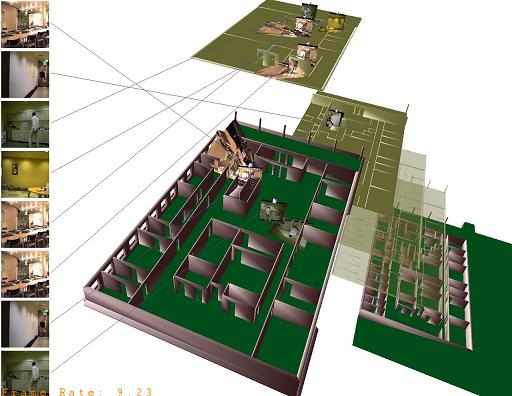
Contextualized Videos refer to interface designs that combine videos with a model of the 3D environment, or more generally with the context information that can not be easily derived from the videos to improve video understanding. We now communicate on the web using webcams and youtube. Imagine three or ten people from different locations are collaborating with each other, how can one aware the others’ spatial location and social background? How can we understand their activities as a whole? Isn’t it interesting to integrate geographic and a wide variety of context information with the video?
Design Space Exploration
Several existing visualization techniques, such as video texture projection, have been used to aid spatial understanding. We identify and begin to characterize an overall class of visualization techniques that combine video with 3D spatial context. This set of techniques, which we call contextualized videos, forms a design palette which must be well understood so that designers can select and use appropriate techniques that address the requirements of particular spatial video tasks.
In the past research cycle, we identified user tasks in video surveillance that are likely to benefit from contextualized videos, we developed a contextualized video testbed which allows us to explore this design space and compose various video visualizations for evaluation. We then proposed a framework to separate the video, model, and navigation related dimensions of the contextualized video design space. Using the testbed, we identified multiple promising design patterns through user selection of visualization features from the design space, followed by user interviews.
A User Study to Compare Embedded Video with Associated Video
There are multiple important questions to be answered: What are the useful designs within the subspace composed of three design dimensions: the model processing dimension, the video-model layout dimension and the navigation dimension (MLN subspace)? What underlying features make a specific design useful?
We have identified two design features and are preparing a user study to compare them: (1) embedded videos vs. associated video; (2) 3D vs. 2D model.
Journal Articles
Effects of Video Placement and Spatial Context Presentation on Path Reconstruction Tasks with Contextualized Videos Journal Article
In: appear in IEEE Transactions on Visualization and Computer Graphics (Proceedings of IEEE Visualization), 2008.
Contextualized Videos: Combining Videos with Environment Models to Support Situational Understanding Journal Article
In: IEEE Transactions on Visualization and Computer Graphics (Proceedings of IEEE Visualization), vol. 13, no. 6, pp. 1568-1575, 2007.

